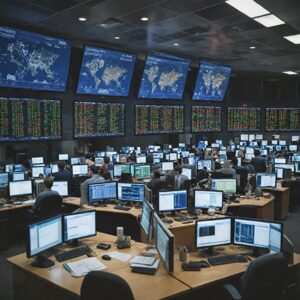Summary
The S&P 500 futures have experienced a notable upward trend entering positive territory for the year 2025, signaling renewed investor confidence amid a complex economic and geopolitical environment. As a key benchmark for U.S. equity markets, the performance of these futures reflects broader market sentiment and expectations for corporate earnings and economic growth. This shift towards a bullish stance is influenced by factors including anticipated policy support, modest inflationary pressures, and improving global economic conditions.
The market optimism emerges despite persistent challenges such as rising geopolitical tensions, trade restrictions, and elevated uncertainty following events like Russia’s invasion of Ukraine and ongoing U.S.-China rivalries. These geopolitical risks have reshaped trade patterns, foreign direct investment flows, and prompted policymakers to focus on economic resilience and monetary stability. At the same time, economic indicators like The Conference Board Coincident Economic Index suggest steady but modest growth, contributing to cautious yet opportunistic investor behavior.
Monetary policy developments, notably the Federal Reserve’s updated framework aiming at maximum employment and price stability, have further bolstered investor confidence by signaling a commitment to sustainable growth and moderate long-term interest rates. However, investor sentiment remains mixed, with various risk indicators pointing to both increased risk appetite and underlying fears, reflecting the uncertainty embedded in the current market environment.
Overall, the rise in S&P 500 futures in 2025 encapsulates a complex interplay of economic policies, geopolitical realignments, and evolving investor sentiment. This dynamic environment presents both opportunities and risks, underscoring the importance of vigilant market analysis and strategic positioning as the year unfolds.
Overview
The S&P 500 futures have shown a notable upward trend as the benchmark index entered positive territory for the year 2025. This movement reflects growing investor confidence and optimism about the economic outlook and corporate earnings in the coming year. Market participants are closely monitoring these futures as indicators of broader market sentiment and potential shifts in risk appetite. The rise in S&P 500 futures underscores a bullish stance among traders, driven by factors such as expected policy support and improving global economic conditions.
Background
The S&P 500 Futures represent a key benchmark for the U.S. equity market, reflecting investor sentiment and economic expectations. Recently, these futures have shown notable gains, pushing the benchmark into positive territory for 2025. This shift comes amid a complex economic landscape shaped by factors such as inflation risk, trade policies, and geopolitical tensions.
Historically, periods of elevated inflation and challenges to Federal Reserve independence have influenced investor behavior, particularly in fixed income markets, where demand for risk premia on long-term bonds increases during times of uncertainty. Current assessments suggest that duration exposure could become more attractive if the 10-year Treasury yield rises to between 4.6% and 4.8%. Additionally, trade policies—including tariffs and import price changes—play a significant role in shaping business confidence and capital expenditures. For example, higher import prices can stimulate domestic GDP by shifting consumer demand away from imports, but retaliatory measures from other countries may negatively impact U.S. exports, thus creating a mixed effect on economic growth.
Geopolitical risks have also intensified in recent years, with the geopolitical risk index spiking notably after Russia’s 2022 invasion of Ukraine. This escalation has coincided with a sharp increase in new trade restrictions and financial sanctions, more than tripling since 2019. Despite these headwinds, institutional investors appear cautiously optimistic, gradually adopting a more “risk on” stance and “buying the dip” amid the prevailing uncertainty and market volatility.
Recent Developments Leading to 2025
Several key economic and geopolitical factors have influenced the trajectory of the S&P 500 futures as the benchmark entered positive territory for 2025. Notably, rising geopolitical tensions, trade restrictions, and shifts in foreign direct investment have reshaped market dynamics. Since 2019, new trade restrictions have more than tripled, and financial sanctions have expanded significantly, largely driven by events such as Russia’s invasion of Ukraine, which caused a sharp spike in the geopolitical risk index in 2022. These developments have prompted policymakers to focus increasingly on economic resilience amid shifting global alignments and reevaluation of reliance on the U.S. dollar for international transactions and reserves.
Economic indicators have also played a crucial role. The Conference Board Coincident Economic Index (CEI) for the United States recorded a modest 0.1% increase in March 2025, reaching 114.4 (2016=100), following a 0.3% rise in February. This reflects a gradual but steady growth of 0.8% over the six months from September 2024 to March 2025, slightly up from the previous six-month period. The CEI, which includes payroll employment, personal income excluding transfer payments, manufacturing and trade sales, and industrial production, is a key metric for assessing the current state of the economy and potential recession risks.
Investor sentiment during this period has been notably cautious yet opportunistic. Several sentiment indicators, including Goldman Sachs’ Z-score for equity allocations, the National Association of Active Investment Managers (NAIIM) Exposure Index, and the CNN Business “Fear and Greed” index, suggest a gradual shift from risk-off to more risk-on positioning among institutional investors. Despite prevailing uncertainties, some investors are “buying the dip,” interpreting current volatility as temporary. Conversely, metrics such as the U.S. Conference Board’s sentiment measure reveal a steep decline in expectations for stock performance over the next year, while Deutsche Bank data shows decreased positioning in both large and small-cap stocks, illustrating a mixed but gradually improving risk appetite.
Monetary policy developments have further shaped market expectations. In November 2024, the Federal Reserve announced updates to its monetary policy framework aimed at promoting maximum employment and price stability, emphasizing longer-run goals and strategies to reduce the size of its balance sheet. These efforts signal a commitment to maintaining a stable financial environment conducive to sustainable growth and moderate long-term interest rates, which positively influences investor confidence in the equity markets.
Geopolitical and External Factors
The geopolitical landscape in 2025 is marked by significant fragmentation driven by ongoing global events such as the COVID-19 pandemic, the war in Ukraine, and escalating tensions between the U.S. and China. These developments have fundamentally altered the previously globalized and geoeconomically integrated world order, introducing heightened geopolitical risks that impact international markets and trade.
One of the foremost risks arises from attacks on critical infrastructure, which threaten energy supplies and broader economic stability. These security concerns intertwine with the escalating effects of climate change, which is contributing to extreme weather events including hurricanes, droughts, floods, and wildfires. Such environmental challenges are damaging infrastructure, disrupting supply chains, and exacerbating resource scarcity, thereby fueling geopolitical tensions. Notably, reduced precipitation in certain regions has heightened water scarcity disputes among countries like Turkey, Syria, and Iraq.
Trade and foreign direct investment (FDI) patterns are also being reshaped by geopolitical considerations. Some nations are willing to accept the rerouting of trade and FDI flows to preserve aspects of economic integration, while others are increasing trade barriers that deepen the divide between politically distant countries. This fragmentation mirrors, to some extent, the trade realignments seen during the Cold War era. Additionally, there has been a notable collapse in direct trade between Russia and Western countries following the Ukraine invasion and subsequent sanctions, underscoring the profound impact of geopolitics on trade relationships.
Economic responses to these geopolitical shifts include reevaluations of reliance on the U.S. dollar for international transactions and reserve holdings, as countries seek greater economic resilience. However, increased import prices resulting from tariffs can lead consumers to substitute domestic goods for imports, positively affecting domestic GDP. Conversely, retaliatory tariffs by other countries can harm export sectors, while heightened trade policy uncertainty tends to suppress business confidence and delay long-term investments. These complex geopolitical and external factors collectively influence market dynamics, including the performance of benchmark indices such as the S&P 500 futures.
Technical Analysis Overview
Technical analysis is a method used by investors and market analysts to evaluate and predict the future price movements of securities and indices by examining historical price data and trading volumes. A central tool in this approach is the moving average, which helps to identify the direction of a trend by smoothing out short-term fluctuations in price. By calculating the average price over a specified period, moving averages provide insight into whether a security is gaining or losing momentum.
Moving averages are commonly employed to detect changes in momentum, such as sudden downward or upward movements in a security’s price, allowing analysts to make more informed trading decisions. Additionally, these indicators are used to assess support and resistance levels—price points where an asset’s movement may pause or reverse—thus offering a clearer picture of market dynamics.
Impact and Implications
The recent climb of the S&P 500 futures into positive territory for 2025 carries significant implications for investors and the broader economic landscape. Institutional investors appear to be gradually shifting toward a more “risk on” stance, potentially viewing current market volatility and uncertainty as temporary and thus “buying the dip” in anticipation of gains. This cautious optimism is also reflected in various sentiment indicators, including the CNN Business “Fear and Greed” index, which signals an “extreme fear position” that may paradoxically indicate a favorable buying opportunity.
From a policy and economic perspective, key initiatives such as tariffs, immigration, taxes, and deregulation are expected to play a central role in shaping market dynamics and investor behavior throughout 2025. These factors, combined with modest inflationary trends (notably a +0.3 percentage-point increase in the core personal consumption expenditures price index), are projected to positively influence corporate earnings, with S&P 500 Index earnings-per-share (EPS) growth forecasted to increase by approximately 4 percentage points in 2026.
On the geopolitical front, foreign direct investment flows are increasingly being redirected along geopolitical lines, with some countries reconsidering their reliance on the U.S. dollar for international transactions and reserve holdings. This realignment, while challenging, is prompting policymakers to focus on enhancing economic resilience in light of recent global events. Moreover, the broader context of risks—including climate change impacts, extreme weather events, and geopolitical tensions—adds layers of complexity that could affect market stability and long-term investment strategies.
Together, these developments underscore a nuanced investment environment where economic policies, geopolitical shifts, and investor sentiment intertwine, influencing the trajectory of the S&P 500 futures and broader market conditions in 2025. Understanding these interconnected factors is crucial for navigating potential risks and opportunities in the evolving financial landscape.
Comparison with Previous Years and Historical Context
The positive trajectory of the S&P 500 futures in 2025 can be understood within a broader historical and geopolitical framework. In recent years, the global economic environment has shifted dramatically from one characterized by globalization and geoeconomics to a landscape dominated by heightened geopolitical risk. Since 2019, trade restrictions have more than tripled, and financial sanctions have expanded significantly, driven in part by conflicts such as the Russia-Ukraine war, which caused a spike in the geopolitical risk index in 2022. These developments have led to a reevaluation of international financial flows and the reliance on traditional reserve currencies, factors that influence investor behavior and market dynamics.
Comparing the current environment with past periods of economic stress offers additional insight. Historically, episodes of elevated inflation risk and challenges to central bank independence, such as in the early 1970s and early 1980s, prompted investors to demand higher risk premia on long-term bonds. In contrast, the fixed income strategy team currently views duration exposure as more attractive if the 10-year Treasury yield rises to around 4.6%-4.8%, indicating a nuanced market response to ongoing economic challenges. This contrasts with previous periods where uncertainty led to greater risk aversion.
The current period of market optimism, as reflected in the positive performance of S&P 500 futures, also fits into a longer historical continuum of economic cycles. Similar to how moving averages are used in time series analysis to smooth short-term fluctuations and highlight underlying trends, the market’s recent rise can be seen as part of a broader trend emerging from the disruptions of the early 2020s. Thus, the S&P 500’s performance in 2025 represents not only a recovery from recent shocks but also a response to a fundamentally altered global economic and geopolitical context.
Future Outlook
The outlook for the S&P 500 futures in 2025 appears cautiously optimistic, driven by several key economic and geopolitical factors. Investors are advised to closely monitor major policy initiatives involving tariffs, immigration, taxes, and deregulation, as these will significantly influence the economic landscape and corporate earnings potential. Projections indicate a modestly inflationary environment, with a +0.3 percentage-point increase expected in the core personal consumption expenditures price index, alongside a positive impact on corporate earnings, which could see a 4 percentage-point increase in S&P 500 earnings-per-share growth in 2026.
From a macroeconomic perspective, leading economic indicators such as The Conference Board’s Leading Economic Index (LEI) are critical to watch for signs of recession. The “3Ds” rule—comprising the six-month diffusion index and the LEI’s six-month growth rate—serves as a recession warning signal. Should both criteria be met, a recession may be imminent or underway, underscoring the importance of these indicators in framing the near-term economic outlook.
Geopolitical risks remain a significant source of uncertainty heading into 2025. The ongoing impacts of COVID-19, the war in Ukraine, and tensions in U.S.-China relations have contributed to geopolitical fragmentation, disrupting globalization trends and reshaping global economic and political structures. Such fragmentation poses risks to critical infrastructure and energy supplies, while climate change continues to affect national security and global stability through extreme weather events and socioeconomic challenges in developing nations.
Investor sentiment reflects a heightened sense of caution amid these uncertainties. Indicators such as the NAAIM and CNN Business “Fear and Greed” index point to a more “risk off” positioning within actively managed accounts and an “extreme fear” sentiment among investors, which some interpret as a potential buying opportunity.


























